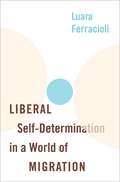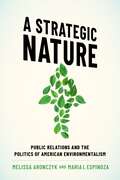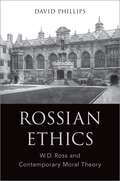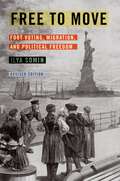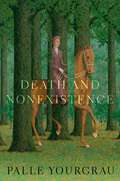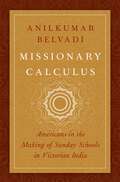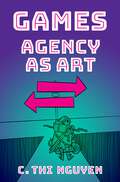- Table View
- List View
Liberal Self-Determination in a World of Migration
by Luara FerracioliThe values of freedom and equality are at the heart of what it means for liberal states to do justice to their citizens. Yet, when it comes to the question of whether liberal states are capable of realizing the values of freedom and equality while controlling their borders, many philosophers are skeptical that liberalism and existing immigration arrangements can in fact be reconciled. After all, liberal states often deny entrance to prospective immigrants who are fleeing extreme forms of violence. They also often police their borders in ways that are discriminatory and stigmatizing, contributing to a situation where immigrants are treated as morally inferior by society at large. Such practices conflict strongly with any commitment to the values of freedom and equality. Luara Ferracioli here focuses on three key questions regarding the movement of persons across international borders: What gives some residents of a liberal society a right to be considered citizens of that society such that they have a claim to make decisions with regard to its political future? And do citizens of a liberal society have a prima facie right to exclude prospective immigrants despite their commitment to the values of freedom and equality? Finally, if citizens have this prima facie right to exclude prospective immigrants, are there moral requirements regarding how they may exercise it? The book therefore tackles the most pressing philosophical questions that arise from immigration: the questions of who can exercise self-determination, and why they have such a right in the first place.
Liberal Self-Determination in a World of Migration
by Luara FerracioliThe values of freedom and equality are at the heart of what it means for liberal states to do justice to their citizens. Yet, when it comes to the question of whether liberal states are capable of realizing the values of freedom and equality while controlling their borders, many philosophers are skeptical that liberalism and existing immigration arrangements can in fact be reconciled. After all, liberal states often deny entrance to prospective immigrants who are fleeing extreme forms of violence. They also often police their borders in ways that are discriminatory and stigmatizing, contributing to a situation where immigrants are treated as morally inferior by society at large. Such practices conflict strongly with any commitment to the values of freedom and equality. Luara Ferracioli here focuses on three key questions regarding the movement of persons across international borders: What gives some residents of a liberal society a right to be considered citizens of that society such that they have a claim to make decisions with regard to its political future? And do citizens of a liberal society have a prima facie right to exclude prospective immigrants despite their commitment to the values of freedom and equality? Finally, if citizens have this prima facie right to exclude prospective immigrants, are there moral requirements regarding how they may exercise it? The book therefore tackles the most pressing philosophical questions that arise from immigration: the questions of who can exercise self-determination, and why they have such a right in the first place.
A Strategic Nature: Public Relations and the Politics of American Environmentalism
by Melissa Aronczyk Maria I. EspinozaA look at how public relations has dominated public understanding of the natural environment for over one hundred years. In A Strategic Nature, Melissa Aronczyk and Maria I. Espinoza examine public relations as a social and political force that shapes both our understanding of the environmental crises we now face and our responses to them. Drawing on in-depth interviews, ethnography, and archival research, Aronczyk and Espinoza document the evolution of PR techniques to control public perception of the environment since the beginning of the twentieth century. More than spin or misinformation, PR affects how institutions and individuals conceptualize environmental problems -- from conservation to coal mining to carbon credits. Revealing the linkages of professional strategists, information politics, and environmental standards, A Strategic Nature shows how public relations restricts alternative paths to a sustainable climate future.
A Strategic Nature: Public Relations and the Politics of American Environmentalism
by Melissa Aronczyk Maria I. EspinozaA look at how public relations has dominated public understanding of the natural environment for over one hundred years. In A Strategic Nature, Melissa Aronczyk and Maria I. Espinoza examine public relations as a social and political force that shapes both our understanding of the environmental crises we now face and our responses to them. Drawing on in-depth interviews, ethnography, and archival research, Aronczyk and Espinoza document the evolution of PR techniques to control public perception of the environment since the beginning of the twentieth century. More than spin or misinformation, PR affects how institutions and individuals conceptualize environmental problems -- from conservation to coal mining to carbon credits. Revealing the linkages of professional strategists, information politics, and environmental standards, A Strategic Nature shows how public relations restricts alternative paths to a sustainable climate future.
An Introduction To The Philosophy Of Religion: (PDF)
by Brian Davies"A deep and precise introduction to the philosophy of religion that is also remarkably clear and insightful. The author has a conversation with the student and uses concrete examples to explain often abstract concepts and issues".
Rossian Ethics: W.D. Ross and Contemporary Moral Theory
by David PhillipsW.D. Ross (1877-1971) was the most important opponent of utilitarianism and consequentialism in British moral philosophy between 1861 and 1939. In Rossian Ethics, David Phillips offers the first monograph devoted exclusively to Ross's seminal contribution to moral philosophy. The book has two connected aims. The first is to interpret and evaluate Ross's moral theory, focusing on its three key elements: his introduction of the concept of prima facie duty, his limited pluralism about the right, and his limited pluralism about the good. The metaethical and epistemological framework within which Ross develops his moral theory is the subject of the fifth and final chapter of the book. The second aim is to articulate a distinctive view intermediate between consequentialism and absolutist deontology, which Phillips calls "classical deontology." According to classical deontology the most fundamental normative principles are principles of prima facie duty, principles which specify general kinds of reasons. Consequentialists are right to think that reasons always derive from goods; ideal utilitarians are right, contra hedonistic utilitarians, to think that there are a small number of distinct kinds of intrinsic goods. But consequentialists are wrong to think that all reasons have the same weight for all agents. Instead there are a small number of distinct kinds of agent-relative intensifiers: features that increase the importance of certain goods for certain agents. Phillips claims that classical deontology combines the best elements of the moral theories of Ross and of Sidgwick, ultimately arguing that Ross is best interpreted as a classical deontologist.
Free to Move: Foot Voting, Migration, and Political Freedom
by Ilya SominBallot box voting is often considered the essence of political freedom. But it has two major shortcomings: individual voters have little chance of making a difference, and they face strong incentives to remain ignorant about the issues at stake. "Voting with your feet," however, avoids both these pitfalls and offers a wider range of choices. In Free to Move, Ilya Somin explains how broadening opportunities for foot voting can greatly enhance political liberty for millions of people around the world. People can vote with their feet through international migration, choosing where to live within a federal system, and by making decisions in the private sector. Somin addresses a variety of common objections to expanded migration rights, including claims that the "self-determination" of natives requires giving them the power to exclude migrants, and arguments that migration is likely to have harmful side effects, such as undermining political institutions, overburdening the welfare state, increasing crime and terrorism, and spreading undesirable cultural values. While these objections are usually directed at international migration, Somin shows how a consistent commitment to such theories would also justify severe restrictions on domestic freedom of movement. By making a systematic case for a more open world, Free to Move challenges conventional wisdom on both the left and the right. This revised and expanded edition addresses key new issues, including fears that migration could spread dangerous diseases, such as Covid-19, claims that immigrants might generate a political backlash that threatens democracy, and the impact of remote work.
Leibniz on the Problem of Evil
by Paul RateauPaul Rateau traces the genesis and development of G.W. Leibniz's treatment of the problem of evil, from his earliest writings through the Essays on Theodicy (1710). By investigating Leibniz's early thinking about what evil is and where it comes from, Rateau reveals the deeply original nature of Leibniz's later work and the challenges it raises. Rateau explores the ways in which the Theodicy's theoretical project, which integrates numerous disciplines and various argumentative strategies, informs and is influenced by two more practical aims-justifying the end of denominational divisions between Catholics and Protestants, and inculcating "true piety" in believers. By paying equal attention to both Leibniz's intellectual and personal development, Rateau offers a holistic view of Leibniz's most profound and sophisticated work of philosophy. Rateau shows how the young Leibniz moves from suggesting that the author of evil is God himself to later defending an original theory of necessitarianism (in The Confession of a Philosopher), which makes God the first link in the chain of beings that constitute the world, but which ultimately denies God's responsibility for sin. By examining Leibniz's theoretical development after 1673, he demonstrates how Leibniz comes to a revised framework that forms the basis for the project of theodicy. After having examined the defensive and the doctrinal aspects of the Theodicy, Rateau shows how human freedom can be reconciled with divine freedom in Leibniz's system. Newly translated from the original French edition, Rateau's book offers a novel and important new interpretation of Leibniz and will appeal to scholars both of Leibniz and of early modern thought generally.
Joseph Smith's Translation: The Words and Worlds of Early Mormonism
by Samuel Morris BrownMormonism's founder, Joseph Smith, claimed to have translated ancient scriptures. He dictated an American Bible from metal plates reportedly buried by ancient Jews in a nearby hill, and produced an Egyptian "Book of Abraham" derived from funerary papyri he extracted from a collection of mummies he bought from a traveling showman. In addition, he rewrote sections of the King James Version as a "New Translation" of the Bible. Smith and his followers used the term translation to describe the genesis of these English scriptures, which remain canonical for the Church of Jesus Christ of Latter-day Saints. Whether one believes him or not, the discussion has focused on whether Smith's English texts represent literal translations of extant source documents. On closer inspection, though, Smith's translations are far more metaphysical than linguistic. In Joseph Smith's Translation, Samuel Morris Brown argues that these translations express the mystical power of language and scripture to interconnect people across barriers of space and time, especially in the developing Mormon temple liturgy. He shows that Smith was devoted to an ancient metaphysics--especially the principle of correspondence, the concept of "as above, so below"--that provided an infrastructure for bridging the human and the divine as well as for his textual interpretive projects. Joseph Smith's projects of metaphysical translation place Mormonism at the productive edge of the transitions associated with shifts toward "secular modernity." This transition into modern worldviews intensified, complexly, in nineteenth-century America. The evolving legacies of Reformation and Enlightenment were the sea in which early Mormons swam, says Brown. Smith's translations and the theology that supported them illuminate the power and vulnerability of the Mormon critique of American culture in transition. This complex critique continues to resonate and illuminate to the present day.
Joseph Smith's Translation: The Words and Worlds of Early Mormonism
by Samuel Morris BrownMormonism's founder, Joseph Smith, claimed to have translated ancient scriptures. He dictated an American Bible from metal plates reportedly buried by ancient Jews in a nearby hill, and produced an Egyptian "Book of Abraham" derived from funerary papyri he extracted from a collection of mummies he bought from a traveling showman. In addition, he rewrote sections of the King James Version as a "New Translation" of the Bible. Smith and his followers used the term translation to describe the genesis of these English scriptures, which remain canonical for the Church of Jesus Christ of Latter-day Saints. Whether one believes him or not, the discussion has focused on whether Smith's English texts represent literal translations of extant source documents. On closer inspection, though, Smith's translations are far more metaphysical than linguistic. In Joseph Smith's Translation, Samuel Morris Brown argues that these translations express the mystical power of language and scripture to interconnect people across barriers of space and time, especially in the developing Mormon temple liturgy. He shows that Smith was devoted to an ancient metaphysics--especially the principle of correspondence, the concept of "as above, so below"--that provided an infrastructure for bridging the human and the divine as well as for his textual interpretive projects. Joseph Smith's projects of metaphysical translation place Mormonism at the productive edge of the transitions associated with shifts toward "secular modernity." This transition into modern worldviews intensified, complexly, in nineteenth-century America. The evolving legacies of Reformation and Enlightenment were the sea in which early Mormons swam, says Brown. Smith's translations and the theology that supported them illuminate the power and vulnerability of the Mormon critique of American culture in transition. This complex critique continues to resonate and illuminate to the present day.
What Snowflakes Get Right: Free Speech, Truth, and Equality on Campus
by Ulrich BaerAngry debates about polarizing speakers have roiled college campuses. Conservatives accuse universities of muzzling unpopular opinions, betraying their values of open inquiry; students sympathetic to the left openly advocate against completely unregulated speech, asking for "safe spaces" and protection against visiting speakers and even curricula they feel disrespects them. Some even call these students "snowflakes"-too fragile to be exposed to opinions and ideas that challenge their worldviews. How might universities resolve these debates about free speech, which pit their students' welfare against the university's commitment to free inquiry and open debate? Ulrich Baer here provides a new way of looking at this dilemma. He explains how the current dichotomy is false and is not really about the feelings of offended students, or protecting an open marketplace of ideas. Rather, what is really at stake is our democracy's commitment to equality, and the university's critical role as an arbiter of truth. He shows how and why free speech has become the rallying cry that forges an otherwise uneasy alliance of liberals and ultra-conservatives, and why this First Amendment absolutism is untenable in law and society in general. He draws on law, philosophy, and his extensive experience as a university administrator to show that the lens of equality can resolve this impasse, and can allow the university to serve as a model for democracy that upholds both truth and equality as its founding principles.
What Snowflakes Get Right: Free Speech, Truth, and Equality on Campus
by Ulrich BaerAngry debates about polarizing speakers have roiled college campuses. Conservatives accuse universities of muzzling unpopular opinions, betraying their values of open inquiry; students sympathetic to the left openly advocate against completely unregulated speech, asking for "safe spaces" and protection against visiting speakers and even curricula they feel disrespects them. Some even call these students "snowflakes"-too fragile to be exposed to opinions and ideas that challenge their worldviews. How might universities resolve these debates about free speech, which pit their students' welfare against the university's commitment to free inquiry and open debate? Ulrich Baer here provides a new way of looking at this dilemma. He explains how the current dichotomy is false and is not really about the feelings of offended students, or protecting an open marketplace of ideas. Rather, what is really at stake is our democracy's commitment to equality, and the university's critical role as an arbiter of truth. He shows how and why free speech has become the rallying cry that forges an otherwise uneasy alliance of liberals and ultra-conservatives, and why this First Amendment absolutism is untenable in law and society in general. He draws on law, philosophy, and his extensive experience as a university administrator to show that the lens of equality can resolve this impasse, and can allow the university to serve as a model for democracy that upholds both truth and equality as its founding principles.
STRUCTURAL INJUSTICE C: Power, Advantage, and Human Rights
by Madison Powers Ruth FadenMadison Powers and Ruth Faden here develop an innovative theory of structural injustice that links human rights norms and fairness norms. Norms of both kinds are grounded in an account of well-being. Their well-being account provides the foundation for human rights, explains the depth of unfairness of systematic patterns of disadvantage, and locates the unfairness of power relations in forms of control some groups have over the well-being of other groups. They explain how human rights violations and structurally unfair patterns of power and advantage are so often interconnected. Unlike theories of structural injustice tailored for largely benign social processes, Powers and Faden's theory addresses typical patterns of structural injustice-those in which the wrongful conduct of identifiable agents creates or sustains mutually reinforcing forms of injustice. These patterns exist both within nation-states and across national boundaries. However, this theory rejects the claim that for a structural theory to be broadly applicable both within and across national boundaries its central claims must be universally endorsable. Instead, Powers and Faden find support for their theory in examples of structural injustice around the world, and in the insights and perspectives of related social movements. Their theory also differs from approaches that make enhanced democratic decision-making or the global extension of republican institutions the centerpiece of proposed remedies. Instead, the theory focuses on justifiable forms of resistance in circumstances in which institutions are unwilling or unable to address pressing problems of injustice. The insights developed in Structural Injustice will interest not only scholars and students in a range of disciplines from political philosophy to feminist theory and environmental justice, but also activists and journalists engaged with issues of social justice.
Structural Injustice: Power, Advantage, and Human Rights
by Madison Powers Ruth FadenMadison Powers and Ruth Faden here develop an innovative theory of structural injustice that links human rights norms and fairness norms. Norms of both kinds are grounded in an account of well-being. Their well-being account provides the foundation for human rights, explains the depth of unfairness of systematic patterns of disadvantage, and locates the unfairness of power relations in forms of control some groups have over the well-being of other groups. They explain how human rights violations and structurally unfair patterns of power and advantage are so often interconnected. Unlike theories of structural injustice tailored for largely benign social processes, Powers and Faden's theory addresses typical patterns of structural injustice-those in which the wrongful conduct of identifiable agents creates or sustains mutually reinforcing forms of injustice. These patterns exist both within nation-states and across national boundaries. However, this theory rejects the claim that for a structural theory to be broadly applicable both within and across national boundaries its central claims must be universally endorsable. Instead, Powers and Faden find support for their theory in examples of structural injustice around the world, and in the insights and perspectives of related social movements. Their theory also differs from approaches that make enhanced democratic decision-making or the global extension of republican institutions the centerpiece of proposed remedies. Instead, the theory focuses on justifiable forms of resistance in circumstances in which institutions are unwilling or unable to address pressing problems of injustice. The insights developed in Structural Injustice will interest not only scholars and students in a range of disciplines from political philosophy to feminist theory and environmental justice, but also activists and journalists engaged with issues of social justice.
DEATH & NONEXISTENCE C
by Palle YourgrauThe dead are gone. They count for nothing. Yet, if we count the dead, their number is staggering. And they account for most of what is great about civilization. Compared to the greatness of the dead, the accomplishments of the living are paltry. Which is it then: are the dead still there to be counted or not? And if they are still there, where exactly is "there"? We are confronted with the ancient paradox of nonexistence bequeathed us by Parmenides. The mystery of death is the mystery of nonexistence. A successful attempt to provide a metaphysics of death, then, must resolve the paradox of nonexistence. That is the aim of this study. At the same time, the metaphysics of death, of ceasing to exist, must serve as an account of birth, of coming to exist; the primary thesis of this book is that this demands going beyond existence and nonexistence to include what underlies both, which one can call, following tradition, "being." The dead and the unborn are therefore objects that lack existence but not being. Nonexistent objects - not corpses, or skeletons, or memories, all of which are existent objects - are what are "there" to be counted when we count the dead.
Language Pangs: On Pain and the Origin of Language
by Ilit FerberWe usually think about language and pain as opposites, the one being about expression and connection, the other destructive, "beyond words" so to speak, and isolating. Language Pangs challenges these familiar conceptions and offers a radical reconsideration of the relationship between pain and language in terms of an essential interconnectedness. Ilit Ferber's premise is that we cannot probe the experience of pain without taking account its inherent relation to language; and vice versa, that our understanding of the nature of language essentially depends on how we take account of its correspondence with pain. Language Pangs brings together discussions of philosophical as well as literary texts, an intersection that is especially productive in considering the phenomenology of pain and its bearing on language. Ferber explores a phenomenology of pain and its relation to language, before providing a unique close reading of Johann Gottfried Herder's Treatise on the Origin of Language, the first modern philosophical text to consider language and pain, establishing the cry of pain as the origin of language. Herder also raises important claims regarding the relationship between human and animal, questions of sympathy and the role of hearing in the expression of pain. Beyond Herder, the book grapples with the work of other profound thinkers, including Martin Heidegger, Stanley Cavell, and André Gide, and finally, Sophocles, from them weaving new insights on the experience of pain, expression, sympathy, and hearing.
Language Pangs: On Pain and the Origin of Language
by Ilit FerberWe usually think about language and pain as opposites, the one being about expression and connection, the other destructive, "beyond words" so to speak, and isolating. Language Pangs challenges these familiar conceptions and offers a radical reconsideration of the relationship between pain and language in terms of an essential interconnectedness. Ilit Ferber's premise is that we cannot probe the experience of pain without taking account its inherent relation to language; and vice versa, that our understanding of the nature of language essentially depends on how we take account of its correspondence with pain. Language Pangs brings together discussions of philosophical as well as literary texts, an intersection that is especially productive in considering the phenomenology of pain and its bearing on language. Ferber explores a phenomenology of pain and its relation to language, before providing a unique close reading of Johann Gottfried Herder's Treatise on the Origin of Language, the first modern philosophical text to consider language and pain, establishing the cry of pain as the origin of language. Herder also raises important claims regarding the relationship between human and animal, questions of sympathy and the role of hearing in the expression of pain. Beyond Herder, the book grapples with the work of other profound thinkers, including Martin Heidegger, Stanley Cavell, and André Gide, and finally, Sophocles, from them weaving new insights on the experience of pain, expression, sympathy, and hearing.
Missionary Calculus: Americans in the Making of Sunday Schools in Victorian India (AAR Religion, Culture, and History)
by Anilkumar BelvadiHow are religious educational institutions built? In histories of evangelical institution-building in the Victorian Indian colonial period (1858-1901), this question has mostly been addressed from the perspective of the religious ends that Christian missionaries sought to achieve and the ideological obstacles they encountered. This may be called the 'values' approach. Missionary Calculus sets this aside and examines, instead, the most routine transactions of missionaries in building an evangelical institution, the Sunday school. Missionaries daily struggled with and acted upon certain questions: How shall we acquire land and money to set up such schools? What methods shall we employ to attract students? What curriculum, books, and classroom materials shall we use? How shall we tune our hymns? Shall we employ non-Christians to teach in Christian Sunday schools? The makers of colonial Sunday schools focused obsessively on the means, the material and symbolic resources, with which they felt they could achieve certain immediate objectives. Such a transactional or 'instrumental' approach resulted in stated religious 'values' being insidiously compromised. Using insights from classical Weberian sociology, and through a close scrutiny of missionary means, this book shows how the success or failure of meeting evangelical ends may be assessed. With extensive archival research, chiefly on American missionaries in colonial India, this work examines the formation of Sunday schools at the point of transnational, intercultural contact. Readers interested in religion, education, and colonial history should find the matter, method, outcomes, and narration of Missionary Calculus new and thought-provoking.
Missionary Calculus: Americans in the Making of Sunday Schools in Victorian India (AAR Religion, Culture, and History)
by Anilkumar BelvadiHow are religious educational institutions built? In histories of evangelical institution-building in the Victorian Indian colonial period (1858-1901), this question has mostly been addressed from the perspective of the religious ends that Christian missionaries sought to achieve and the ideological obstacles they encountered. This may be called the 'values' approach. Missionary Calculus sets this aside and examines, instead, the most routine transactions of missionaries in building an evangelical institution, the Sunday school. Missionaries daily struggled with and acted upon certain questions: How shall we acquire land and money to set up such schools? What methods shall we employ to attract students? What curriculum, books, and classroom materials shall we use? How shall we tune our hymns? Shall we employ non-Christians to teach in Christian Sunday schools? The makers of colonial Sunday schools focused obsessively on the means, the material and symbolic resources, with which they felt they could achieve certain immediate objectives. Such a transactional or 'instrumental' approach resulted in stated religious 'values' being insidiously compromised. Using insights from classical Weberian sociology, and through a close scrutiny of missionary means, this book shows how the success or failure of meeting evangelical ends may be assessed. With extensive archival research, chiefly on American missionaries in colonial India, this work examines the formation of Sunday schools at the point of transnational, intercultural contact. Readers interested in religion, education, and colonial history should find the matter, method, outcomes, and narration of Missionary Calculus new and thought-provoking.
Mastery, Dependence, and the Ethics of Authority
by Aaron StalnakerOver the last few decades, skepticism about political and moral experts has grown into a serious social problem, undermining the functioning of liberal democratic regimes. Indeed, meritocracy-that is, government by hard working, public-spirited people with high levels of relevant expertise-has never looked so promising as an alternative to the dangers of know-nothing populism. One cultural tradition has devoted sustained attention to the idea of meritocracy, as well as to the cultivation of true expertise or mastery: Confucianism. Mastery, Dependence, and the Ethics of Authority presents a compelling analysis of expertise and authority, and examines classical Confucian conceptions of mastery, dependence, and human relationships in order to suggest new approaches to these issues in ethics and political theory. Contemporary Westerners are heirs to multiple traditions that are suspicious of authority, especially coercive political authority. We are also increasingly wary of dependence, which now often seems to signify weakness, neediness, and pathology. Analysts commonly presume that both authority and dependence threaten human autonomy, and are thus intrinsically problematic. But these judgments are mistaken. Our capacity for autonomy needs to be cultivated over time through deliberate practices of training, in which we depend on the guidance of virtuous and skilled teachers. Confucian thought provides a subtle and powerful analysis of one version of this training process, and of the social supports such an education in autonomy requires-as well as the social value of having virtuous and skilled leaders. Early Confucians also argue that human life is marked by numerous interacting forms of dependence, which are not only ineradicable, but in many ways good. On a Confucian view, it is natural, healthy, and good for people to be deeply dependent on others in a variety of ways across the full human lifespan. They teach us that individual autonomy only develops within a social matrix, structured by relationships of mutual dependence that can either help or hinder it, including a variety of authority relations.
Mastery, Dependence, and the Ethics of Authority
by Aaron StalnakerOver the last few decades, skepticism about political and moral experts has grown into a serious social problem, undermining the functioning of liberal democratic regimes. Indeed, meritocracy-that is, government by hard working, public-spirited people with high levels of relevant expertise-has never looked so promising as an alternative to the dangers of know-nothing populism. One cultural tradition has devoted sustained attention to the idea of meritocracy, as well as to the cultivation of true expertise or mastery: Confucianism. Mastery, Dependence, and the Ethics of Authority presents a compelling analysis of expertise and authority, and examines classical Confucian conceptions of mastery, dependence, and human relationships in order to suggest new approaches to these issues in ethics and political theory. Contemporary Westerners are heirs to multiple traditions that are suspicious of authority, especially coercive political authority. We are also increasingly wary of dependence, which now often seems to signify weakness, neediness, and pathology. Analysts commonly presume that both authority and dependence threaten human autonomy, and are thus intrinsically problematic. But these judgments are mistaken. Our capacity for autonomy needs to be cultivated over time through deliberate practices of training, in which we depend on the guidance of virtuous and skilled teachers. Confucian thought provides a subtle and powerful analysis of one version of this training process, and of the social supports such an education in autonomy requires-as well as the social value of having virtuous and skilled leaders. Early Confucians also argue that human life is marked by numerous interacting forms of dependence, which are not only ineradicable, but in many ways good. On a Confucian view, it is natural, healthy, and good for people to be deeply dependent on others in a variety of ways across the full human lifespan. They teach us that individual autonomy only develops within a social matrix, structured by relationships of mutual dependence that can either help or hinder it, including a variety of authority relations.
Games: Agency As Art (Thinking Art)
by C. Thi NguyenGames are a unique art form. Games work in the medium of agency. Game designers tell us who to be and what to care about during the game. Game designers sculpt alternate agencies, and game players submerge themselves in those alternate agencies. Thus, the fact that we play games demonstrates the fluidity of our own agency. We can throw ourselves, for a little while, into a different and temporary motivations. This volume presents a new theory of games which insists on their unique value. C. Thi Nguyen argues that games are an integral part our systems of communication and our art. Games sculpt our practical activities, allowing us to experience the beauty of our own actions and reasoning. Bridging aesthetics and practical reasoning, he gives an account of the special motivational structure involved in playing games. When we play games, we can pursue a goal, not for its own value, but for the value of the struggle. Thus, playing games involves a motivational inversion from normal life. We adopt an interest in winning temporarily, so we can experience the beauty of the struggle. Games offer us a temporary experience of life under utterly clear values, in a world engineered to fit to our abilities and goals. Games also let us to experience forms of agency we might never have developed on our own. Games, it turns out, are a special technique for communication. They are a technology that lets us record and transmit forms of agency. Our games form a "library of agency" and we can explore that library to develop our autonomy. Games use temporary restrictions to force us into new postures of agency.
Games: Agency As Art (Thinking Art)
by C. Thi NguyenGames are a unique art form. Games work in the medium of agency. Game designers tell us who to be and what to care about during the game. Game designers sculpt alternate agencies, and game players submerge themselves in those alternate agencies. Thus, the fact that we play games demonstrates the fluidity of our own agency. We can throw ourselves, for a little while, into a different and temporary motivations. This volume presents a new theory of games which insists on their unique value. C. Thi Nguyen argues that games are an integral part our systems of communication and our art. Games sculpt our practical activities, allowing us to experience the beauty of our own actions and reasoning. Bridging aesthetics and practical reasoning, he gives an account of the special motivational structure involved in playing games. When we play games, we can pursue a goal, not for its own value, but for the value of the struggle. Thus, playing games involves a motivational inversion from normal life. We adopt an interest in winning temporarily, so we can experience the beauty of the struggle. Games offer us a temporary experience of life under utterly clear values, in a world engineered to fit to our abilities and goals. Games also let us to experience forms of agency we might never have developed on our own. Games, it turns out, are a special technique for communication. They are a technology that lets us record and transmit forms of agency. Our games form a "library of agency" and we can explore that library to develop our autonomy. Games use temporary restrictions to force us into new postures of agency.
ANSCOMBE'S INTENTION OGP C: A Guide (Oxford Guides to Philosophy)
by John SchwenklerWritten against the background of her controversial opposition to the University of Oxford's awarding of an honorary degree to Harry S. Truman, Elizabeth Anscombe's Intention laid the groundwork she thought necessary for a proper ethical evaluation of actions like the bombing of Hiroshima and Nagasaki. The devoutly Catholic Anscombe thought that these actions made Truman a murderer, and thus unworthy of the university's honor-but that this verdict depended on an understanding of intentional action that had been widely rejected in contemporary moral philosophy. Intention was her attempt to work out that understanding and argue for its superiority over a conception of intention as an inner mental state. Though recognized universally as one of the definitive works in analytic philosophy of action, Anscombe's book is often dismissed as unsystematic or obscure, and usually read through the lens of philosophical concerns very far from her own. Schwenkler's Guide offers a careful and critical presentation of Anscombe's main lines of argument at a level appropriate to advanced undergraduates but also capable of benefiting specialists in action theory, moral philosophy, and the history of analytic philosophy. Further, it situates Intention in a context that emphasizes Anscombe's debts to Aristotle, Aquinas, and Wittgenstein, and her engagement with the work of contemporaries like Gilbert Ryle and R.M. Hare, inviting new avenues of engagement with the ideas of historically important philosophers.
Anscombe's Intention: A Guide (Oxford Guides to Philosophy)
by John SchwenklerWritten against the background of her controversial opposition to the University of Oxford's awarding of an honorary degree to Harry S. Truman, Elizabeth Anscombe's Intention laid the groundwork she thought necessary for a proper ethical evaluation of actions like the bombing of Hiroshima and Nagasaki. The devoutly Catholic Anscombe thought that these actions made Truman a murderer, and thus unworthy of the university's honor-but that this verdict depended on an understanding of intentional action that had been widely rejected in contemporary moral philosophy. Intention was her attempt to work out that understanding and argue for its superiority over a conception of intention as an inner mental state. Though recognized universally as one of the definitive works in analytic philosophy of action, Anscombe's book is often dismissed as unsystematic or obscure, and usually read through the lens of philosophical concerns very far from her own. Schwenkler's Guide offers a careful and critical presentation of Anscombe's main lines of argument at a level appropriate to advanced undergraduates but also capable of benefiting specialists in action theory, moral philosophy, and the history of analytic philosophy. Further, it situates Intention in a context that emphasizes Anscombe's debts to Aristotle, Aquinas, and Wittgenstein, and her engagement with the work of contemporaries like Gilbert Ryle and R.M. Hare, inviting new avenues of engagement with the ideas of historically important philosophers.
